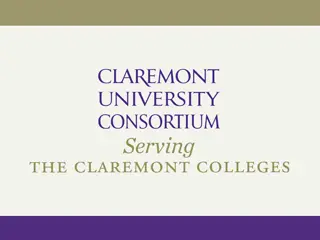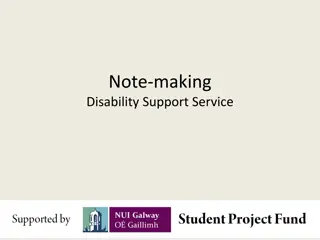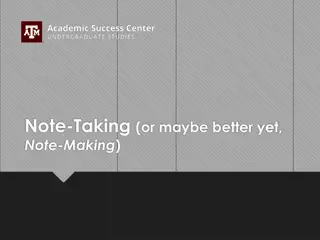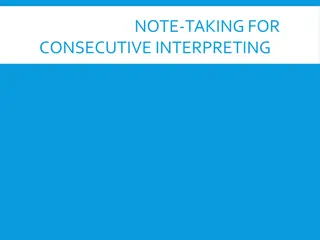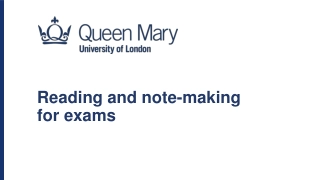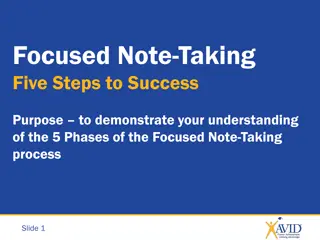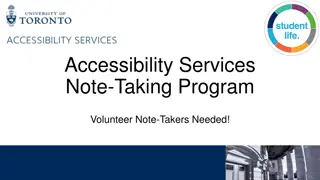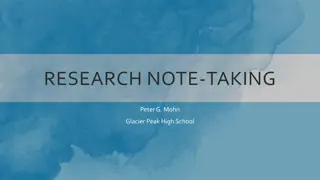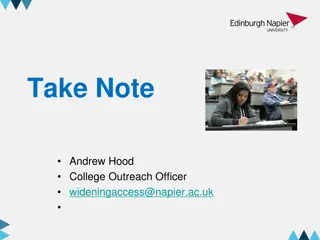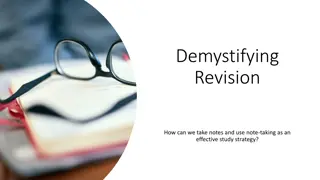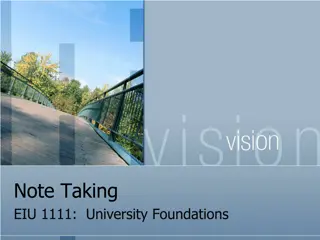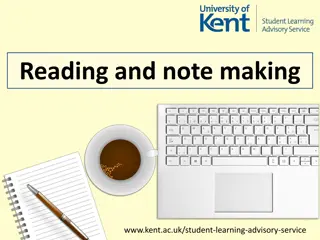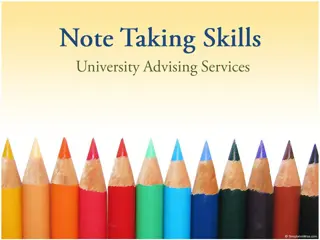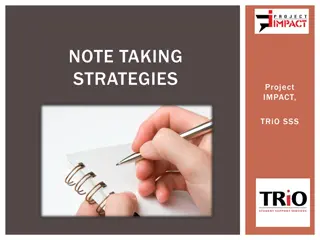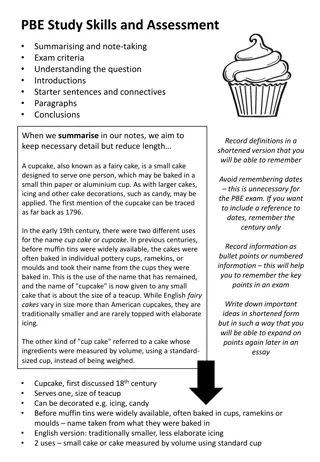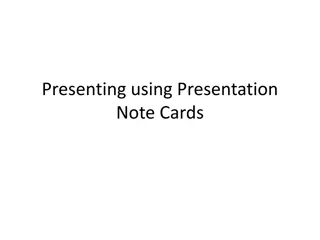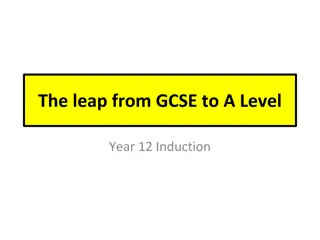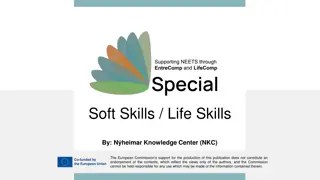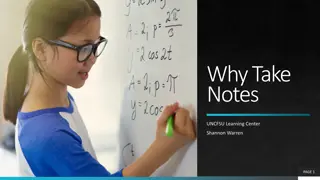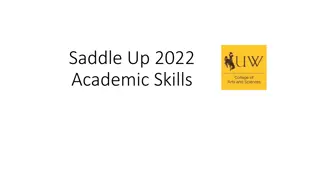Mastering Note-Making Skills for Effective Learning
Note-making is a crucial skill for condensing large volumes of information into concise, organized summaries. It aids in remembering key details, preparing for exams, planning presentations, and engaging in discussions. This practice requires selecting and extracting relevant data, using abbreviations, and structuring notes with titles, subheadings, and key points. Effective note-making strategies involve group work, identifying challenges, and developing essential skills for capturing and retaining information efficiently.
Download Presentation

Please find below an Image/Link to download the presentation.
The content on the website is provided AS IS for your information and personal use only. It may not be sold, licensed, or shared on other websites without obtaining consent from the author. Download presentation by click this link. If you encounter any issues during the download, it is possible that the publisher has removed the file from their server.
E N D
Presentation Transcript
ENGLISH CORE XI &XII
NOTE-MAKING 1. what Note-making is 2.the features of Notes according to the given Format 3.to select and extract information and record it in note form 4. to use appropriate Key/Abbreviations in the Note 5. to write the Summary of the Note within the given word limit
INTRODUCTION NOTE MAKING is a special skill that is very useful to students and working professio nals. It enables one to compress a large piece of information into a BRIEF, ORGANIZED and SUMMARIZED piece which can be referred to when required.
How are Notes helpful to us? To remember important details To prepare for examinations To plan Debates, Speeches and Lectures and participate To give Speeches and Lectures To take part in Discussions Note-Making is a practical skill that can be used in different areas
STRATEGIES TO DEAL WITH CHALLENGES 1.work in groups. 2. What challenge do you foresee in Note Making ?
2. What can you do to overcome these challenges? 3. what skills does a learner need to demonstrate while making Notes?
Brainstorm in groups a list of dos and don ts for making Notes. Do s Don ts
Features of Note Making a TITLE/HEADING proper INDENTATION INDENTATION to distinguish between Main and Supporting points To be divided into SUB-HEADINGS and SUB-SUB HEADINGS The number of Sub-headings is usually four KEY/ABBREVIATIONS (such as NCERT, DOE and SCERT)
Abbreviate whenever possible SYMBOLS(such as %, &, @) SHORT FORMS (such as govt.) at least four abbreviations Examples and quotations not be a part of the Note brief: a key phrase for a sentence; a word to represent a phrase No Long and complete sentences
Format of a Note HEADING 1. Main - heading a. Sub-heading i. Sub-sub heading ii Sub-sub heading b. Sub-heading i. Sub-sub heading ii. Sub-sub heading 2. Main-heading 3. Main-heading 4. Main-heading
Abbreviations and Symbols can be used in the following manner: a) Well-known abbreviations (WHO, SCERT, NCERT, CBSE ) b)Symbols (e.g., i.e., etc, &, %} c) Self-created abbreviations (Govt., Pvt., Ltd., S.St.) d)Self-created contractions (prblm. problem; e) rqd. required; edn. - education
Abbreviations and Symbols can be used in the following manner: a) Well-known abbreviations (WHO, SCERT, NCERT,CBSE) b)Symbols (e.g., i.e., etc, &, %} c) Self-created abbreviations (Govt., Pvt., Ltd., S.St.) d)Self-created contractions (prblm. problem; rqd. requi red; edn. - education
Lets learn to make Notes In your group list the tasks for organising the following events: 1. Birth day party 2. Teachers Day 3. Sports Day 4. Annual Day 5. A festival 6. Tree Plantation 7. Marriage anniversary of your Parents/cousins /friends
Prepare shopping lists Prepare shopping lists task wise
Brainstorm in a group of four to unjumble the steps given here for Note Making Ask the students to take up the first main idea and find out two or three things about it from the passage. a. Students should repeat one by one the above exercise with rest of the main ideas. b. Discuss the format of a good note making with the students. c. d. Teach the students how to frame and use Key/Abbreviations Now teach them to write a Summary of the Passage. e. f. Ask them to write the title of the Notes Now, direct them to think of four most important things they learned from the text . These are the MAIN ideas. g.
Error Correction The following passage has not been edited. There is one error in each line. Write the incorrect wordand the correct word as given in the example agai nst the correct blank number in your answer sheet: Correct Word Incorrect Word Parents and children in the primary e.g. and of or the secondary schools is looking (a) ........... .......... out for part-time jobs who they can (b) ............ .......... manage to do when children be away (c) ............ .......... at school. Manage canteens of their (d) ............ .......... own child's school will gave them a (e) ............ .......... very good opportunity. When there is a (f)........... .......... holiday they will also have an break as (g) ............ .......... the canteen will not worked when the school is closed. (h) ............ .........
Answers: Correct Word Incorrect Word (a) Is are (b) Who which (c) be are (d) Manage Managing (e) Gave give (f) When Whenever (g) an a (h) worked work
STRATEGIES TO DEAL WITH CHALLENGES 1.work in groups. 2. What challenge do you foresee in Error Correction ?
Areas of common errors 1. Pronoun 2. Number (Singular and Plural) 3. Subject Verb Agreement 4. Tense 5. form of Verb 6. Article 7. Determiners
2.work in pairs and write whether true or false against each : Use the indefinite article the only with a singular count noun w hose specific identity is not known . . Use a before nouns that begin with a consonant sound, and us e an before nouns that begin with a vowel Use the article the when the noun refers to something or someo ne that is unique. Use article with plural count nouns or any noncount nouns use d to mean all or in general. Never use articles before Proper Noun The past Tense is easy, only need put the ed in end Use did not for negative sentences in Past Tense


